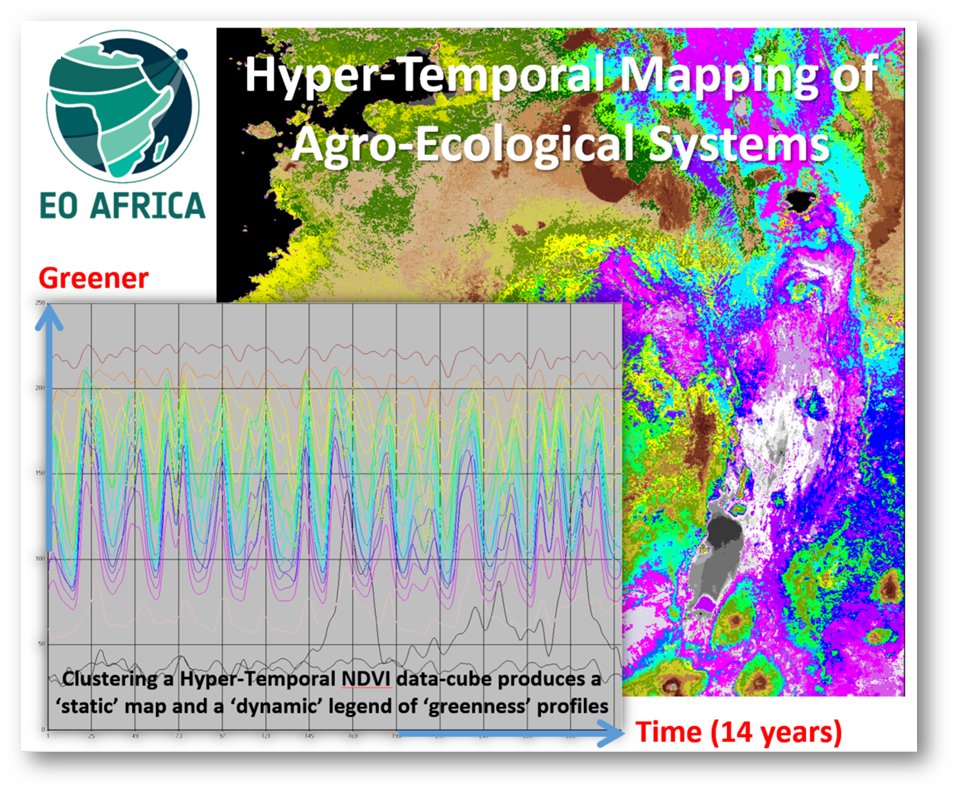EO AFRICA R&D Facility Online Course
Hyper-Temporal Mapping of Agro-Ecosystems & Assessing Land Suitability
-
(4 weeks with a daily study-load of 2 hours – total load 40 hours)

Introduction to the course
From early 2000 onwards, the availability of high-quality Hyper-Temporal (HT) EO, has created an enormous number of additional possibilities to map and detect changes as required to monitor impacts. Use of the dimensions “space & time” now lets us study and work on issues that earlier remained “out-of-reach” and remained “unanswered”, like:
- creating benchmark maps that clearly include important temporal characteristics (this course).
- exploring the potential of the temporal dimension of satellite EO data for monitoring vegetation dynamics and land cover/land use changes over longer periods of time (next course).
In addition, logic to link agro-ecological conditions to crop requirements will be presented using tools like GAEZ, EcoCrop and CropBase. Through a 12-hour case-study, participants will practice knowledge gained, i.e. to map agro-ecosystems through the use of hyper-temporal imagery.
Upon completion of this online course, the participant will be able:
- to understand the concepts of vegetation stability, resistance and resilience.
- to list sources of Hyper-Temporal (HT) NDVI-imagery and describe their required pre-processing steps.
- to use HT-imagery to map agro-ecosystems , i.e. to explain and defend:
- why HT NDVI-data are functional to map at country/regional level “What is Where and When”, and
- how we capture “Climatology” aspects of “Crop Production Systems Zones”.
- to specify in a legend of a HT-based map: (i) what is there, (ii) what is its density, and (iii) what is its temporal annual behaviour.
- to relate climate, soil and terrain conditions, as relevant to agricultural production, to given crop requirements, and thus to identify suitable crops for a specific use and environment.
Mode of Delivery
The course consists of videos, PowerPoints, quizzes and practical exercises, supplemented by reading material and reference materials. Moodle-Cloud will be used as learning platform including a forum for Q&A’s. Zoom will be used as interactive platform for live-sessions.
Prerequisites
The participants need to have basic programming skills in Python.
Having studied the online course on Cloud Computing and Algorithms for EO Analyses would be beneficial. Note: Access to both courses will be given to those selected to attend thison-line course.
Selection
The course will be offered to a maximum of 65 participants. Selection will be based on relevant academic background and employment. We will strive to have a gender-balanced and country-balanced group of participants. Preference is given to candidates working as (Ph.D.-) researchers, post-doc, and university staff. Selection will be made four weeks before the course starts to provide early access to prerequisite online courses on Cloud computing and EO.
Timeline
The online course will have live introduction and Q&A sessions on: [ All CET-times which is UTC+1 ]
- Monday, Feb-06 10:00 AM + Thursday, Feb-09 16:00 PM
- Monday, Feb-13 16:00 PM + Thursday, Feb-16 16:00 PM
- Monday, Feb-20 16:00 PM + Thursday, Feb-23 16:00 PM
- Monday, Feb-27 16:00 PM + Thursday, Mar-02 16:00 PM
Registration:
Teachers:
-

Associate Professor – Department of Natural Resources, Faculty ITC of the University of Twente
https://people.utwente.nl/c.a.j.m.debie
mailto:c.a.j.m.debie@utwente.nl -

Assistant Professor – Department of Natural Resources, Faculty ITC of the University of Twente
https://people.utwente.nl/f.j.ellsaesser
mailto:f.j.ellsaesser@utwente.nl
